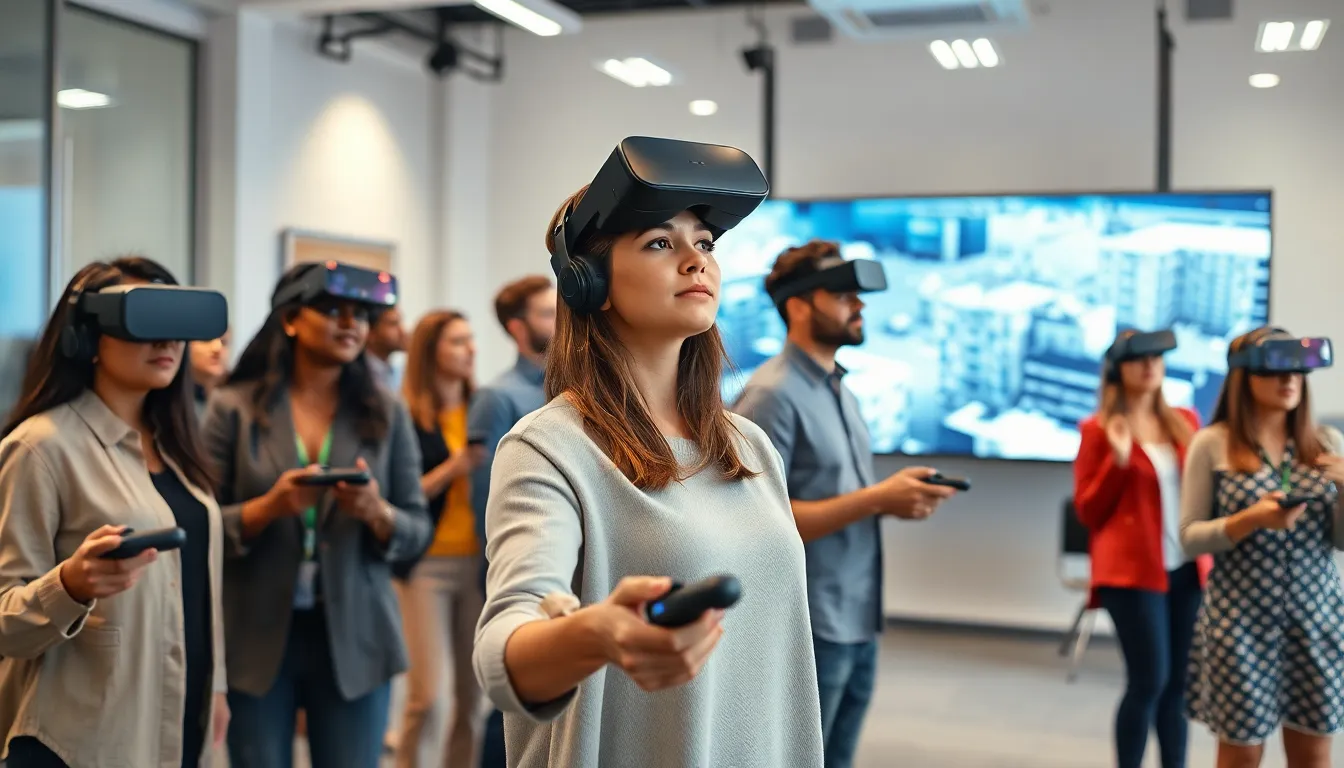In today’s fast-paced digital world, immersive tech experiences are transforming how people interact with technology. From virtual reality to augmented reality, these innovations create captivating environments that engage users like never before. This shift is not just a trend; it’s a revolution in entertainment, education, and even everyday tasks.
As industries embrace these technologies, they open doors to endless possibilities. Imagine exploring distant galaxies from your living room or attending a virtual concert with friends across the globe. Immersive tech is reshaping experiences, making them more interactive and memorable. Understanding this evolution is crucial for anyone looking to stay ahead in a rapidly changing landscape.
Table of Contents
ToggleOverview of Immersive Tech Experiences
Immersive tech experiences encompass a range of technologies, including virtual reality (VR), augmented reality (AR), and mixed reality (MR). These technologies enable users to engage with digital environments that feel real and interactive.
Virtual Reality (VR)
- VR offers complete immersion through headsets that block out the physical world. Users can experience 360-degree environments, driving engagement in gaming, training, and simulations. Examples include Oculus Rift and HTC Vive.
Augmented Reality (AR)
- AR overlays digital information onto the real world, enhancing user interaction without complete immersion. Popular applications include Pokémon GO and Snapchat filters, allowing for interactive marketing campaigns and educational tools.
Mixed Reality (MR)
- MR combines elements of both VR and AR, merging real-world and digital content. Microsoft’s HoloLens exemplifies MR, enabling users to manipulate holograms in real spaces. Industries like healthcare leverage MR for training and surgical simulations.
Impact on Various Sectors
- Immersive tech experiences revolutionize sectors, including entertainment, education, and real estate. In entertainment, VR games provide engaging narratives. In education, AR enhances textbooks with interactive content. In real estate, 3D virtual tours allow property exploration from anywhere.
User Engagement
- User engagement increases with immersive technology, promoting interaction and collaboration. Studies indicate VR can lead to higher retention rates in educational environments and increased customer satisfaction in retail applications.
By integrating immersive technologies, organizations create dynamic experiences that captivate users, foster creativity, and drive innovation.
Types of Immersive Tech Experiences

Immersive tech experiences can be categorized into three primary types: virtual reality (VR), augmented reality (AR), and mixed reality (MR). Each type offers unique interactions and applications across various industries.
Virtual Reality
Virtual reality creates entirely immersive digital environments, enabling users to engage through headsets and controllers. Industries such as gaming and training extensively utilize VR for its ability to simulate real-life scenarios. Examples include flight simulators for pilot training and immersive gaming experiences like Beat Saber. The technology fosters a heightened sense of presence, allowing users to experience situations that would be impossible or impractical in real life.
Augmented Reality
Augmented reality enhances the real world by overlaying digital elements onto physical environments. This technology is prevalent in smartphone applications, such as GPS navigation and retail shopping apps that showcase products in user surroundings. A notable example is Pokémon GO, which integrates virtual creatures into real-world locations. AR increases user engagement by providing contextually relevant information and interactive features, making tasks more efficient and enjoyable.
Mixed Reality
Mixed reality combines aspects of both virtual and augmented reality, seamlessly integrating digital content and the physical world. Users can interact with digital objects as if they exist in the real environment. Microsoft’s HoloLens serves as a prominent example, offering applications in healthcare for surgical training and remote collaboration. MR enables innovative solutions by promoting interactive and collaborative experiences, enhancing both user engagement and learning outcomes.
Applications of Immersive Tech Experiences
Immersive technologies find significant applications across various sectors, enhancing user experiences and outcomes. This section explores their roles in education and training, entertainment and gaming, and healthcare.
Education and Training
Immersive technology enhances education and training by providing interactive learning environments. VR enables students to explore historical sites and complex scientific concepts, improving engagement and retention. AR facilitates hands-on experiences by overlaying information onto physical objects, making learning more intuitive. For example, platforms like Google Expeditions allow educators to take students on virtual field trips, enriching classroom experiences. These immersive techniques also offer remote training possibilities, enabling employees to gain skills in simulated environments, which increases competency and confidence in real-world applications.
Entertainment and Gaming
Immersive tech transforms entertainment and gaming through captivating experiences. VR creates fully immersive environments, allowing players to step into virtual worlds and interact with characters, as seen in titles like Half-Life: Alyx. AR enhances gaming by blending digital elements into the real world, exemplified by Pokémon GO, which encourages physical exploration. Additionally, immersive experiences in theme parks use MR to combine digital elements with live attractions, heightening visitor engagement. These advancements not only increase user satisfaction but also drive growth in the entertainment industry, appealing to a broader audience.
Health Care
Immersive technologies revolutionize healthcare by offering innovative training and treatment methods. VR simulates surgery and complex medical procedures, providing safe spaces for practitioners to hone their skills. Medical students can practice in virtual environments before performing real-life operations, reducing risks and improving patient outcomes. AR supports surgical procedures by overlaying critical information onto a surgeon’s field of view, enhancing precision and efficiency. Furthermore, MR applications aid in patient therapy, addressing phobias and anxiety through controlled exposure in virtual settings. These applications foster better learning and improved patient care in healthcare.
Benefits of Immersive Tech Experiences
Immersive tech experiences provide numerous advantages across various sectors. These benefits significantly enhance engagement and learning outcomes for users.
Enhanced Engagement
Immersive technologies, including VR, AR, and MR, drive user participation through engaging environments. Users become active participants rather than passive observers, leading to deeper interactions. For instance, VR gaming allows players to physically move and engage with virtual settings, enhancing emotional involvement. AR applications, like Pokémon GO, encourage exploration and collaboration in real-world contexts, increasing social connections. Additionally, businesses utilizing immersive experiences see elevated customer satisfaction, as interactions become more personalized and memorable.
Improved Learning Outcomes
Immersive experiences transform traditional education methods, leading to superior learning results. VR and AR facilitate interactive learning environments, allowing students to visualize complex concepts and engage with subjects like history or science in an immersive way. Studies show that learners retain information better when concepts are presented through engaging technology. Training programs leveraging VR for simulations enable employees to practice skills in a risk-free environment, resulting in improved performance and confidence. These enhanced learning outcomes directly contribute to workforce competency and readiness in various industries.
Challenges and Considerations
Immersive technologies present several challenges that organizations must address to fully leverage their potential. Key considerations include accessibility issues and the costs associated with implementation.
Accessibility Issues
Access to immersive technology experiences can be limited for individuals with disabilities. VR environments often lack compatibility with accessibility features, making navigation difficult for users with mobility impairments. AR applications might not provide sufficient auditory or visual support for users with hearing or vision challenges. Moreover, high-tech equipment requires users to have specific physical capabilities, which not everyone possesses. Designing inclusive experiences is crucial to ensure that all users can engage with these technologies effectively. Organizations must prioritize accessibility when developing immersive experiences to create a more inclusive environment for all users.
Cost and Implementation
Implementing immersive technology involves significant financial investment. The costs associated with hardware, software, and content development can be substantial. Organizations often face expenses related to purchasing advanced hardware like VR headsets or AR glasses, as well as licensing fees for software and platforms. Additionally, training staff to manage and maintain the technology adds to the overall cost. Furthermore, successful implementation requires a strategic plan that addresses infrastructure and user training, which can extend project timelines and budgets. Organizations must weigh these costs against the potential benefits to determine the viability of immersive technology for their specific needs.
Immersive tech experiences are undeniably reshaping the way individuals interact with technology across various sectors. The integration of VR AR and MR enhances engagement and fosters creativity while driving innovation. As organizations navigate the challenges associated with these technologies they must prioritize inclusivity and strategic planning to maximize benefits. The potential for immersive experiences to transform learning training and entertainment is immense and it’s crucial for businesses to stay ahead in this rapidly evolving landscape. By embracing these advancements they can create captivating experiences that not only meet user needs but also elevate overall satisfaction and retention.



